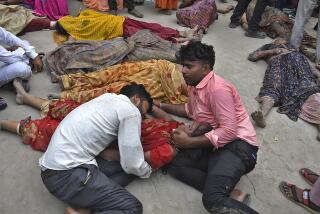10 Million Hindu Pilgrims Converge on Ganges City
- Share via
HARIDWAR, India — An estimated 10 million people converged on the banks of the Ganges River in this holy Hindu city Tuesday at the climax of the Kumbh Mela, the world’s largest religious gathering.
Hindu pilgrims, some covered only by holy ash, plunged into the river, believing its rushing water would wash away their sins and free them from the cycle of death and rebirth.
“I came to do some good and put 10 years of bad luck behind me,” said Chapala Sadhu Khan, a 50-year-old widow from Calcutta. She said she sneaked onto a train and traveled 14 hours to Haridwar. While she said she is so poor that it is difficult to find food at home, she knew that “here there would be kindness.”
The Kumbh bathing ritual occurs every 12 years at Haridwar, a temple-filled town clinging to the foothills of the Himalayas, 125 miles north of New Delhi.
Astrologers deemed Tuesday the most auspicious day of the four-month festival that began Jan. 1 and ends April 30. Leeladhar Jagoori, a government official monitoring the festival, estimated that 10 million people had bathed in the river beginning overnight.
The festival’s origin lies in Hindu legend: During the creation of the universe, the gods and demons churned the oceans and extracted the prized kumbh, or pitcher, containing the nectar of immortality.
During the struggle for possession of the kumbh, drops of nectar spilled at four Indian locales, sanctifying them for all time. Kumbh observances are held every three years, rotating among the four sites.
More to Read
Sign up for Essential California
The most important California stories and recommendations in your inbox every morning.
You may occasionally receive promotional content from the Los Angeles Times.













